Pazzaz Racer 14 inch Kids Bike, Helmet and Knee Pads User manual
- Category
- Bicycles
- Type
- User manual
This manual is also suitable for

IMPORTANT:
This manual contains important safety, performance and service information. Read it before you take the rst
ride on your new bicycle, and keep it for reference.
Additional safety, performance and service information for specic components such as suspension or pedals
on your bicycle, or for accessories such as helmets or lights that you purchase, may also be available. Make
sure that your dealer has given you all the manufacturers’ literature that was included with your bicycle or
accessories. In case of a conict between the instructions in this manual and information provided by a
component manufacturer, always follow the component manufacturer’s instructions.
If you have any questions or do not understand something, take responsibility for your safety and consult
with your dealer or the bicycle’s manufacturer.
NOTE: This manual is not intended as a comprehensive use, service, repair or maintenance manual.
Please see your dealer for all service, repairs or maintenance. Your dealer may also be able to refer you
to classes, clinics or books on bicycle use, service, repair or maintenance.
BICYCLE OWNER’S MANUAL

Like any sport, cycling involves risk of injury and damage. By choosing to ride a bicycle, you assume the
responsibility for that risk, so you need to know — and to practice — the rules of safe and responsible
riding and of proper use and maintenance. Proper use and maintenance of your bicycle reduces risk of
injury.
This Manual contains many warnings and cautions concerning the consequences of failure to maintain
or inspect your bicycle and of failure to follow safe cycling practices.
Many of the Warnings and Cautions say “you may lose control and fall”.
Because any fall can result in serious injury or even death, we do not always repeat the warning of
possible injury or death.
Because it is impossible to anticipate every situation or condition which can occur while riding, this
Manual makes no representation about the safe use of the bicycle under all conditions. There are risks
associated with the use of any bicycle which cannot be predicted or avoided, and which are the sole
responsibility of the rider.
GENERAL WARNING
2

CONTENTS
1. First 4
4. Maintenance 28
2. Safety 5
5. Torque Specicaons 33
3. Tech 6
6. Weight Restricons
7. Warranty
34
35
3A. Saddle
3B. Stem
3C. Mudguards
3D. Wheels
3E. Chain Tension
3E. Basket
3F. Stabilisers
3G. Pedals
3H. Brakes
3I. Gears
3J. Rotor / Giro
6
7
9
10
14
15
16
17
18
22
26
3

We strongly urge you to read this Manual in it’s entirety before your child’s rst ride. At the very least, read and make sure that you
understand each point in this section, and refer to the cited sections on any issue which you don’t completely understand.
Ensure you have assembled the bike and ed all loose parts that came in the box.
Check the chain is lubricated.
Make sure all wheel xings are ght and ed correctly.
Check trueness of wheels and tyre pressures.
Make sure your saddle is at the correct riding height and posion and not beyond the minimum inseron mark. Check that
all xings are ght
Make sure you have adjusted the handlebar height and angle to your riding posion (where applicable) and that it is not
beyond the minimum inseron mark. Check all nuts are ght.
Any extras or accessories must be correctly ed and ght.
If your bike is a BMX with a 360 Giro, check that the handlebar can be fully rotated without cables snagging.
Check brake funconality. Adjust if necessary. Right hand lever should operate front brake and le should operate rear. Make
sure you can reach and operate the brakes comfortably from your riding posion.
Make sure your gears change cleanly and that you can operate the gear levers comfortably from your riding posion.
Check chainwheel and crank bolt are ght
1.
2.
3.
4.
5.
6.
7.
8.
9.
10.
11.
4
1. FIRST
WARNING
It is important that you exercise extreme cauon when riding or performing any maintenance / building tasks on
your bike so as not to trap ngers or any other extremity, which can cause serious injury.

5
Make sure your child’s rst ride is in a quiet area away from cars, other cyclists, obstacles etc. Make sure your child becomes familiar
with all the controls and features of their new bike, especially brake performance.
If you feel anything about the bike is not as it should be consult a qualied bicycle mechanic.
Always wear a helmet! Safety gear is also
available for knees, elbows, back, shoulders
and more. It is highly recommended. Protecve
eyeware is also recommended.
You should make sure your child wears
appropriate clothing that is bright and visible
and not too loose. Loose clothing can catch in
moving parts and cause them to lose control
and fall. Be sure they dress in accordance to the
weather. Footwear should be able to grip the
pedals and not have loose laces.
Make sure you / your child know all the local
trac laws and obey them. Bicycles are sharing
the road with others and should always assume
they haven’t been seen and excercise maximum
cauon, especially on busy roads and around
large vehicles.
If your child is going to ride o-road, condions
may require extra aenon and specic skills.
Make sure they get to know their bike well
HELMETS SAVE LIVES!
Always wear a cycling helmet which meets the latest cercaon standards
and is appropriate for the type of riding you do. Always follow the helmet
manufacturer’s instrucons for t, use and care of your helmet. Most serious
bicycle injuries involve head injuries which might have been avoided if the
rider had worn an appropriate helmet.
before trying increased speed or dicult terrain.
Be aware that in wet condions, the bike’s brakes stopping power (and those of other road users) is greatly reduced.
If the bike is going to be ridden at night, make sure you obey all laws regarding lighng and clothing and be aware that cyclists are
oen hard to spot for drivers and pedestrians alike.
Any form of jump, stunt, race or other extreme riding is extremely dangerous and will invalidate your warranty.
2. SAFETY

MINIMUM INSERTION MARK
SHOULD NOT BE VISIBLE
iii
ii
i
To insert saddle or to adjust saddle height, you need to release the seat clamp by turning an-clockwise. This will require a
spanner which was provided in the box with the bike.
Once the seat clamp is released, the seat post will become loose and you will be able to move the saddle up and down.
Once your saddle is at the desired height, ghten up the seat clamp again by turning clockwise as shown.
i
ii
iii
3A SADDLE INSTALLATION & ADJUSTMENT
SADDLE HEIGHT
Saddle height is very important in order to make your child’s cycling experince more enjoyable and of course safer. The correct saddle
height should not cause their knee to lock out with their foot on the pedal in the downward most posion, however their knee
should only be slightly bent.
When adjusng the saddle, always be aware of the minumum inseron mark and always make sure this is not visible above the
frame, or you risk damaging the bicycle or losing control causing serious injury or worse.
3. TECH
6

7
SADDLE FORE AND AFT ADJUSTMENT
Some saddles can also be moved backwards and forwards. For opmal riding posion your child should be able to comfortably reach
the handlebars and use the breaks and gears (if applicable) whist riding with their arms slightly bent at the elbows.
3B STEM INSTALLATION & ADJUSTMENT
Make sure that when you install the stem / handlebar you don’t twist the cables.
To adjust saddle just unfasten the nut under tha saddle using either a spanner or an allen key and turning an-clockwise.
You can then adjust saddle backwards and forwards, ensuring that only the at part of the saddle rail is in the clamp.
Tighten the nut under the saddle back up by turning clockwise
i.
ii.
iii.
iii
ii
i

8
Handlebar rotaon
If you need to adjust the angle of your handlebar, you can do this by losening the
clamping nut. The handlebar will then rotate freely in the stem. Adjust to desired
angle, and ensuring the bar is sll centred in the stem, ghten the clamping bolt.
To adjust or install stem, you need to loosen the centre bolt enough so that the stem will t / become loose in the steerer tube,
by turning it an-clockwise with allen key provided.
You can then insert or adjust the stem. You can rotate it le to right and you can also adjust the height. It is very important
that you observe the minimum inseron mark and that you insert the stem beyond this. This must not be visible once the
stem is installed.
Once your stem is in place and in line with the forks, ghten it up by turning the centre bolt clockwise (it may be easier to re-
adjust this with the front wheel ed, so the stem is in line with it).
i
i ii iii
ii
iii
MINIMUM
INSERTION
MARK
Front of bike
Rear of bike
TIGHTEN LOOSEN

9
You MUST make sure the stem & handlebar is inserted beyond the minimum inseron mark. If you don’t you may damage
the bike or the stem. You may also lose control and fall, which could cause you serious injury. Once you have nished
assembling you should test the stem by holding the front wheel between your leg and trying to turn the handlebars. If
these turn without turning the front wheel you need to line the handlebar back up and re-ghten.
WARNING
3C MUDGUARD INSTALLATION
Your bike may have come equipped with mudguards. The front mudguard will usually come separate in the box and will need ng.
First, remove the nut from the bolt in the top of
the fork using the spanner provided, leave the bolt
in place through the fork. Then remove the two
screws from the feet of the fork using a crosshead
screwdriver.
You can then locate the mudguard in place. First feed
the mudguard through the back of the fork as shown.
Locate the mudguard on the bolt you le in the fork
as and screw the nut on clockwise unl it is nger
ght. You can then screw the mudguard to the feet of
the fork by replacing screws through the mudguard
brackets and into the fork, ghtening them by turning
clockwise with a crosshead screwdriver. Tighten the
nut on the top of the fork turning clockwise using the
spanner provided.
i
ii

10
3D WHEEL INSTALLATION & ADJUSTMENT
The wheel axles are inserted into slots, called “dropouts” in the fork and frame. Examples below
Dropouts come in way too many dierent shapes and sizes to be able to illustrate them all here, but these examples should guide
you to indenfying where your dropouts are.
FORK DROPOUT REAR DROPOUT
NUTTED WHEEL SYSTEM
DROPOUTS
NUTS
WHEEL HUB
How does it work?
The wheel hub is clamped in place by the force of the nuts against
the dropouts. The amount of clamping force is controlled by the
ghtness of the nuts. Turning the tnuts clockwise increases clamping
force; turning them counterclockwise reduces clamping force.
Both nuts need ghtening to correct torque, available at the rear of
this manual

11
Installing and adjusng a front wheel with a nued system
If your bike comes with a nued front wheel, the nuts will usually come already on the front wheel.
Make sure the wheel nuts are loosened by turning anclockwise,
exposing as much of the thread as possible.
i
For this step, as long as your saddle and handlebar
are installed, it helps to turn the bike upside down.
You should then insert the wheel into the dropouts as
shown, ensuring that the locking washers are on the
outside of the fork as shown.
You may need to release the brakes to get the wheel
through. If this is the case, go the brakes secon of
this manual where you will nd instrucons on how
to do this.
ii
LOCKING
WASHER
NUTS
AXLE
FORK

12
If your bike comes with a tradional basket the bracket for this needs be installed before we can secure the wheel in place. You
will need to remove the nuts completely from the front wheel before sing the wheel in the front dropouts.
With the wheel sat in the fork, insert the locking washers on to the axles, securing the pin in place as shown.
Then insert the basket bracket, with the at part facing towards the bike frame as shown.
Finally, screw the nut on clockwise. You should only screw this on nger ght for the me being, we will ghten it once
the basket is installed.
a
b
c
IF YOU HAVE A TRADITIONAL BASKET
THE PIN ON THE
LOCKING WASHER
MUST BE PLACED
IN THE HOLE.
a b c
Should you need to remove your wheel to replace it or to repair it, simply reverse these steps.
Place the pointed side of the locking washer into the hole
in the fork as shown, then ensuring the gap between the
wheel and the fork is equal on both sides, ghten the
nut by turning clockwise using a spanner. Recommended
torques can be found at the back of this catalogue
iii
THE PIN ON THE LOCKING
WASHER MUST BE PLACED
IN THE HOLE.

13
If you disengaged your brake to get the wheel in, it is very important that you now re-engage it. Visit the brakes secon of
this manual for instrucons on how to do this.
WARNING
Removing or adjusng a rear wheel with a nued system
This step is easier with the bike upside down, resng on the saddle and the handlebars. For that purpose, the images here show what
these steps look like with the bike upside down.
Should your bike have gears, shi the rear derailleur to high gear (the smallest, outermost rear sprocket).
You then may need to release the brakes to get enough clearance for the wheel to pass through. Should this be the case, see
the brakes secon in this manual for instrucons on how to do this.
i
ii
When you come to replace your wheel, simply reverse these steps.
iii
iv
v
Loosen the nuts on the wheel, then push the wheel forward far enough to be able to remove the chain from the rear sprocket.
Should your bike have gears, pull the derailleur body back with your right hand to release the tension on the chain and hold
it there for the next step.
You can now remove the wheel out of the dropouts.

14
3E. CHAIN TENSION
Single Speed Bikes
There should be approximately 10mm total movement in the middle of the chain underside. Having the chain too loose can lead to it coming
o, too ght can make it dicult to pedal and lead to premature failure of the freewheel, chainwheel or chain.
Chain tension is varied by loosening the rear wheel and moving it in or out slightly (see wheels secon). Normally tension needs to be applied
while the nuts are being ghtened in order to stop the axle slipping forwards
Geared Bikes
No adjustment should be needed, as the derailleur tensions the chain.
10mm

15
3F. BASKET INSTALLATION
If your bike is either a heritage or trekking style bike, it may have come with a basket. There are two main types of basket, tradional and quick
release.
Tradional basket
If you have a tradional wicker or faux wicker basket, rst you will need to t the basket bracket on the wheel axle. This explained in the wheel
secon of this manual. If your wheel is already installed, you may need to loosen the nuts to get the bracket in place. Once you have done this,
follow these steps to install the basket.
Make sure the stem basket braket is facing the front and that the fork
basket bracket is above the wheel in the horizontal posion as shown.
Sit the basket on the fork bracket with the xing plate towards the
stem bracket, making sure the cables don’t get in the way.
Line the base plate on the bracket up with the holes on the basket
bracket, and drop 2 xing screws with washers in the holes as
shown.
Place two washers and screw on the two nuts from underneath
as shown, turning clockwise unl nger ght.
i
ii
STEM BASKET
BRACKET
FORK BASKET
BRACKET
FIXING
SCREWS
TOP VIEW BOTTOM VIEW

16
Line the holes in the basket plate and the frame bracket up and
insert the screws / washers / xing plate as shown. Then from
behind the frame bracket, place the washers on the screws and
screw the nuts on clockwise nger ght.
iii
3G. STABILISERS
Remove the outer nut and washer from each side of the back wheel by turning an-clockwise using the spanner provided
Place the bracket over the thread ensuring the tabs lock in the dropout, followed by the stabiliser, the washer and the nut. Tighten the
nut by turning clockwise unl it is nger ght. Repeat for the other side.
Once both stabilisers are nger ght, ensure they are both around 5mm from the
ground with the bike vercal. This is to ensure that if the bike goes over uneven ground
the rear wheel won’t be lied of the ground causing it to lose tracon.
Tighten both nuts by turning clockwise using the spanner provided
i
ii
iii
iv
WARNING
Stabilisers are an important
balancing aid for young children.
Bikes equipped with stabilisers
should not be ridden on uneven
ground. Regularly check all
stabiliser ngs, including the
locking tabs to ensure nothing
has come loose. If you are
unsure please contact your local
bike dealer who should be able
to help you.

17
3H. PEDALS
Pedals are marked wether they t in the le or the right. It is very important to insert the correct pedal into the correct crank arm, as if you don’t
you could cross thread them and cause irreparable damage not covered by warranty.
Sckers indicate the le and right pedal. If these have dropped o, look at the end of the thread where it is imprinted.
The correct pedal needs to be aached to the matching side of the bike i.e. le pedal to le side and right pedal to right side.
IMPORTANT! Pedals need screwing in opposite direcons so they don’t fall o in use.
Le pedal is screwed in an-clockwise / Right pedal is screwed in clockwise. Tighten pedals with spanner provided.
i
ii
iii
L
R
THREADS
L R
SCREW ANTI-CLOCKWISE
LEFT
SCREW CLOCKWISE
RIGHT

18
3I. BRAKES
It’s very important for your child’s safety that they learn and remember which brake lever controls which brake on your bike. Tradionally, the
le brake lever controls the rear brake and the right brake lever controls the front brake; but, to make sure your child’s bike’s brakes are set up
this way, squeeze one brake lever and look to see which brake, front or rear, engages. Now do the same with the other brake lever.
Make sure that their hands can reach and squeeze the brake levers comfortably. If their hands are too small to operate the levers comfortably,
consult your local bike shop before riding the bike. The lever reach may be adjustable; or you may need a dierent brake lever design.
How brakes work
The braking acon of a bicycle is a funcon of the fricon between the braking surfaces. To make sure that you have maximum fricon
available, keep your wheel rims and brake pads free of dirt, lubricants, waxes or polishes.
Brakes are designed to control your speed, not just to stop the bike. Maximum braking force for each wheel occurs at the point just before the
wheel “locks up” (stops rotang) and starts to skid. Once the tyre skids, you actually lose most of your stopping force and all direconal control.
You need to pracce slowing and stopping smoothly without locking up a wheel.
The technique is called progressive brake modulaon. Instead of jerking the brake lever to the posion where you think you’ll generate the
appropriate braking force, squeeze the lever, progressively increasing the braking force.
If you feel the wheel begin to lock up, release pressure just a lile to keep the wheel rotang just short of lockup. It’s important to develop a
feel for the amount of brake lever pressure required for each wheel at dierent speeds and on dierent surfaces. To beer understand this,
experiment a lile by walking your bike and applying dierent amounts of pressure to each brake lever, unl the wheel locks.
When you apply one or both brakes, the bike begins to slow, but your body wants to connue at the speed at which it was going. This causes a
transfer of weight to the front wheel (or, under heavy braking, around the front wheel hub, which could send you ying over the handlebars).
A wheel with more weight on it will accept greater brake pressure before lockup; a wheel with less weight will lock up with less brake pressure.
So, as you apply brakes and your weight is transferred forward, you need to shi your body toward the rear of the bike, to transfer weight
back on to the rear wheel; and at the same me, you need to both decrease rear braking and increase front braking force. This is even more
important on descents, because descents shi weight forward.
Two keys to eecve speed control and safe stopping are controlling wheel lockup and weight transfer. This weight transfer is even more
pronounced if your bike has a front suspension fork. Front suspension “dips” under braking, increasing the weight transfer. Pracce braking and
weight transfer techniques where there is no trac or other hazards and distracons.
Everything changes when you ride on loose surfaces or in wet weather. It will take longer to stop on loose surfaces or in wet weather. Tire
adhesion is reduced, so the wheels have less cornering and braking tracon and can lock up with less brake force. Moisture or dirt on the brake
pads reduces their ability to grip. The way to maintain control on loose or wet surfaces is to go more slowly.

19
RIM BRAKES
Rim brakes work by squeezing brake pads (usually made out of rubber) against the rim in order to slow the wheel down. Brakes are
a very important part of the bike, and you need to familiarize yourself with which type of brake you have. It is important that you
keep these serviced. You may need to adjust the brakes, and you may need to release and engage them in order to replace a wheel.
In this manual you will nd a guide on how to do these. However if you are unsure about anything to do with your brakes or their
funcons, you should consult a qualied bicycle mechanic before riding your bike.
You should regularly check these points and adjust accordingly (these rules do not apply for disc brakes). If you are unsure, consult
a qualied bicycle mechanic:
Check the brake pads are
square to the rim
Both brake pads should be parallel and equal distance
from the rim (1-1.5mm). As brake pads begin to wear
you can ne tune the distance from the pad to the rim
by turning the cable adjuster screw on the brake lever.
Your brake arms may also have an adjuster on them,
see this secon to determine which type of brakes your
bike has.
The brake pads should not be
worn beyond the wear line
and you should replace these
before the pad is worn out.
Also...
Both brake arms should move the same distance when you squeeze the brake lever
The rim should run freely through the brake pads with no contact when the brake is open
The brake pads should touch the rim before the brake lever is 1/3 of the way to the handlebar.
1-1.5mm1 -1.5mm
RIM
WEAR LINE
CABLE ADJUSTER
BARREL

20
BRAKE PADS
Usually made from
rubber, these rub against
the rim to slow the wheel
BRAKE ARMS
Move inwards to press the
brake pads against the
rim of the wheel
BRAKE CABLE
Operates the brake arms
when the brake lever on
the handlebars is pulled
BRAKE PAD ADJUSTMENT AND
REMOVAL BOLT
This bolt secures the brake pad to
the brake arm and can be released
to adjust the angle of the brake
pad, or to remove the brake pad
completely to replace when worn
CABLE GUIDE PIPE (NOODLE)
Hooks into the left hand arm and
connects the two
brake arms so that they both
move towards the
wheel when the brake lever is
pulled
V BRAKES
i
ii
To release your V brakes in order
to t or replace your wheel, pull
back the black rubber protector
and squeeze the to brake arms
together. Whilst holding these
you can pull the brake out by the
noodle as shown.
To re-engage your brakes once
wheel is tted, you need to
squeeze the brake arms together
again and reverse step ii.
CABLE PINCH BOLT
This bolt secures the brake
cable to the brakes. You can
release this bolt to adjust the
distance from the brake arm
to the wheel
SPRING TENSION SCREW
Adjusts spring strength
for each brake arm. Turn
clockwise to increase
tension and anti-clockwise
to decrease.
Page is loading ...
Page is loading ...
Page is loading ...
Page is loading ...
Page is loading ...
Page is loading ...
Page is loading ...
Page is loading ...
Page is loading ...
Page is loading ...
Page is loading ...
Page is loading ...
Page is loading ...
Page is loading ...
Page is loading ...
Page is loading ...
-
 1
1
-
 2
2
-
 3
3
-
 4
4
-
 5
5
-
 6
6
-
 7
7
-
 8
8
-
 9
9
-
 10
10
-
 11
11
-
 12
12
-
 13
13
-
 14
14
-
 15
15
-
 16
16
-
 17
17
-
 18
18
-
 19
19
-
 20
20
-
 21
21
-
 22
22
-
 23
23
-
 24
24
-
 25
25
-
 26
26
-
 27
27
-
 28
28
-
 29
29
-
 30
30
-
 31
31
-
 32
32
-
 33
33
-
 34
34
-
 35
35
-
 36
36
Pazzaz Racer 14 inch Kids Bike, Helmet and Knee Pads User manual
- Category
- Bicycles
- Type
- User manual
- This manual is also suitable for
Ask a question and I''ll find the answer in the document
Finding information in a document is now easier with AI
Related papers
Other documents
-
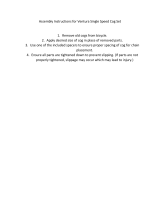 Ventura 320070 Operating instructions
Ventura 320070 Operating instructions
-
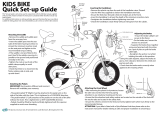 Elswick SPYDA BOYS 16 FS BIKE User manual
Elswick SPYDA BOYS 16 FS BIKE User manual
-
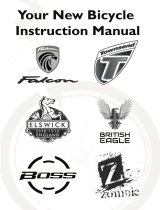 MVSports Group 2894465 User manual
MVSports Group 2894465 User manual
-
Falcon B2614093 User manual
-
Momentum Bicycle Owner's manual
-
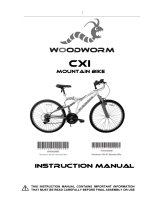 Woodworm Cxi User manual
Woodworm Cxi User manual
-
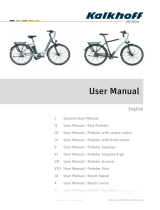 Kalkhoff Bosch Speed User manual
Kalkhoff Bosch Speed User manual
-
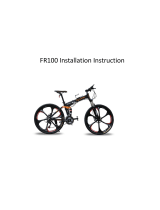 Cyrusher FR100 Installation guide
Cyrusher FR100 Installation guide
-
 EVOTECH Suzuki GSX-S1000 User manual
EVOTECH Suzuki GSX-S1000 User manual
-
Cross FOLD26M1 User manual














































